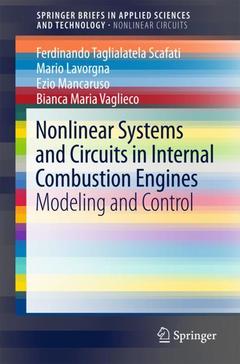Description
Nonlinear Systems and Circuits in Internal Combustion Engines, 1st ed. 2018
Modeling and Control
SpringerBriefs in Nonlinear Circuits Series
Authors: Taglialatela-Scafati Ferdinando, Lavorgna Mario, Mancaruso Ezio, Vaglieco Bianca Maria
Language: English
Subject for Nonlinear Systems and Circuits in Internal Combustion...:
52.74 €
In Print (Delivery period: 15 days).
Add to cartSupport: Print on demand
Description
/li>Contents
/li>Biography
/li>Comment
/li>
This brief provides an overview on the most relevant nonlinear phenomena in internal combustion engines with a particular emphasis on the use of nonlinear circuits in their modelling and control.
The brief contains advanced methodologies ?based on neural networks and soft-computing approaches among others? for the compensation of engine nonlinearities by using the combustion pressure signal and proposes several techniques for the reconstruction of this signal on the basis of different engine parameters, including engine-block vibration and crankshaft rotational speed. Another topic of the book is the diagnosis of the nonlinearities of injection systems and their balancing, which is a mandatory task for the new generation of gasoline direct injection engines.
The authors come from both industrial and academic backgrounds, so the brief represents an important tool both for researchers and practitioners in the automotive industry.These books may interest you

Engine Modeling and ControlModeling and Electronic Management of Internal Combustion Engines 126.59 €



